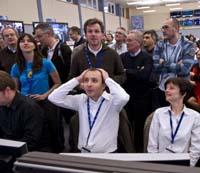Big Brother of scientists
In fact, 10,000 physicists participate in the experiments initiated at the LHC, of which 2,250 belong to the European Nuclear Research Organization (CERN). Among them, they must make technical decisions, interpret data, generate opinions and disseminate knowledge.

LHC particle accelerator control point on the day of commissioning. (Photo: CERN)
Although everyone has similar interests, it can be expected that problems will occasionally arise between them. What kind of problems will there be? How will they overcome them? They are interesting questions for sociologists, anthropologists and philosophers, and surely the answers will be even more interesting. Therefore, several sociologists analyze the physicists community that the LHC brings together.
However, the issue is not new. This article in the journal Nature, for example, mentions the work of Karin Knorr-Cetina. Knorr-Cetina is a sociologist at Constance University in Germany and has spent almost 30 years studying the scientific teams that have participated in CERN experiments.
Knorr-Cetina states that the traditional structure of governmental or industrial organizations is hierarchical. Since the LHC measure is similar to the LHC measure, a similar structure could be expected. Alabaina,Knorr-Cetina has seen that in the LHC the orders are not given from top to bottom. LHC has many sections, all of them very specialized, and the work team that knows the most is the one that investigates in each of them. Therefore, the hierarchical model does not work.
It is not hierarchical, but neither democratic. Knorr-Cetina himself highlights that science is not democratic: "who is right is not decided by a majority." So what is the structure of CERN? In the opinion of this sociologist, it is like a community in which physicists leave their homes and their individuality to work for the benefit of an objective.
Other sociologists warn of the existence of a competition between physicists that can cause conflicts. To avoid this risk, all physicists of research groups who have participated in all scientific articles based on LHC experiments must appear in alphabetical order of the country.
It seems, therefore, that there will be no competition to stand out above others, but much anxiety and stress. At least that is what sociologists have announced and some have advanced that problems can come from there. At the moment, the experiment has only begun and we will have to see what results it gives, both in the physical and sociological fields.
Martian Big Brother
Although the sociological study of LHC is secondary, this aspect is fundamental in other scientific projects. An example of this is the project of going to Mars. Thus, the Russian space agency and the ESA have designed the Mars 500 experiment to analyze the coexistence of a manned journey back and forth to Mars.
During the experiment, six volunteers, all men, have gone into a module that simulates a spacecraft. The goal is to live there for 520 days. During this time, during the trip back and forth to Mars and on the surface of the planet, a team of researchers will analyze their behavior. They report that it can also be seen on the You Tube portal. So if someone wants to see a truly Martian Big Brother, there he will have the opportunity.
Published in Gara
Buletina
Bidali zure helbide elektronikoa eta jaso asteroko buletina zure sarrera-ontzian











